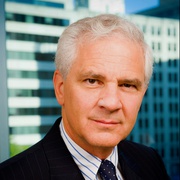
Russian President Vladimir Putin arrives to give his annual state of the nation address in Manezh in Moscow, Russia, Thursday, March 1, 2018. Mikhail Klimentyev, Sputnik, Kremlin Pool Photo via AP
Putin Just Gave Trump the Arms Race He Sought
'Let it be an arms race,' Trump said, two years ago. Now we have one. It doesn't have to be this way.
If you missed the Cold War, it looked a lot like right now, plus a Berlin Wall. Last month, the United States announced three new nuclear weapons to be aimed at Russia, at least in part. This month begins with Russian President Vladimir Putin in his annual state-of-the-nation address unveiling five new nuclear arms of his own — weapons he claims can fly around, under, over, and through any conceivable missile defense system.
Boasting? Absolutely. But it’s like bragging about a muscle car you already have in the garage. These weapons are in development, some are far-fetched, but all are possible. To underscore the point, the last few frames of his “Star Wars”-style computer graphics presentation showed nine nuclear warheads delivered by one new missile heading directly for Mar-a-Lago.
The new missile is monster. The “Sarmat” is a 200-ton, very long-range intercontinental ballistic missile, or ICBM, shown in a cartoon graphic carrying multiple warheads over both the North and South Poles. Why the South? Because all our radars point north and our ground-based interceptor missiles are in Alaska. The "Sarmat will be equipped with a wide range of high-power nuclear ammunition, including hypersonic,” said Putin. “And the most modern systems to overcome missile defense.”
The hypersonic ammunition he mentions is the “Avangard” hypersonic boost-glide weapon. Instead of a free-falling ballistic missile, this weapon, similar to ones under development in the United States and China, would be able to maneuver in flight to evade interceptors. President Putin claims that it “heads towards its target like a meteorite.”
He also showed off the “Kinzhal” hypersonic air-launched cruise missile (possibly with multiple warheads). Like the Avangard, states Putin, the hypersonic speed will guarantee that it will “overcome all existing and, I think, prospective anti-missile systems.”
The most questionable of the new systems is a nuclear-powered, “low-flying, low-visibility cruise missile armed with a nuclear warhead and possessing a practically unlimited range, unpredictable flight path and the capability to impregnate practically all interception lines and is invulnerable to all existing and future anti-missile and air defense weapons," Putin said. During the speech, Putin showed an animation of the cruise missiles flying across the Atlantic, maneuver around radars, going around South America before it reached its destination, presumably the American west coast.
Putin claims one of Russia’s strategic successes is a “small-scale, heavy-duty, nuclear energy unit that can be installed in a missile.” Adding, “in late 2017, Russia successfully launched its latest nuclear-powered missile at the Central training ground….Now that the missile launch and ground tests were successful, we can begin developing a completely new type of weapon, a strategic nuclear weapons system with a nuclear-powered missile.”
And finally, we have an underwater drone that Putin described as capable of operating at “very extreme depths covering intercontinental distances” and would be traveling at speeds much faster than existing underwater machinery. The system, which he noted had been under development for a number of years, claims to be “highly maneuverable and almost invincible to an enemy.” The Defense Department calls the underwater drone the “Status-6” in it’s report on nuclear weapons, called the Nuclear Posture Review, describing it as a “new intercontinental, nuclear-armed, nuclear-powered, undersea autonomous torpedo.” This weapon, too, would face serious operational obstacles but is designed to unleash a massive nuclear explosion just outside port cities, triggering a radioactive tsunami.
Tellingly, Putin says that he spoke to U.S. officials in 2004 about the initial plans for these weapons, but they didn’t listen.
“Listen to us now,” he intones.
If this sounds like an escalatory cycle, you’re paying attention. It may have begun 15 years ago but it got a major boost with the Trump presidency.
“Let it be an arms race,” President Donald Trump told MSNBC in December 2016. He wants to be the “top of the pack” and boasted that “We will outmatch them at every pass and outlast them all.” He has repeated this posture at various points ever since.
Trump now has the arms race he sought.
But it’s not all his fault. In December 2001, when President George W. Bush withdrew from the Anti-Ballistic Missile Treaty that limited the number and location of anti-missile systems, many experts warned that it would lead to a new arms race. It did not immediately, but it certainly has now.
Related: Nuclear Nuts: Trump’s New Policy Hypes The Threat and Brings Us Closer to War
Related: Why Did Trump Pick a Fight with Putin Over the Nuclear Weapons Treaty?
Trump could at least keep the cap on this race by agreeing to extend New START which limits both sides’ offensive forces. The treaty expires in 2021, but could quickly be extended for five years by simple executive agreement. Putin wants to, but Trump rebuffed his request to do so in the first phone call the two leaders had in early 2017.
Better, the two could open up new talks to cut both sides’ massive arsenals. The most effective way to intercept Russia’s new nuclear weapons is to kill them before they are built.
But don’t hold your breath. The new Missile Defense Review set to be released at the end of the month (possibly on March 23, the 35th anniversary of Ronald Reagan’s “Star Wars” speech) will call for a major expansion of our technologically-challenged interceptor system, plus fleets of new space-based weapons and a crash program for 1980’s-style directed energy weapons.
This arms race is just getting warmed up.
